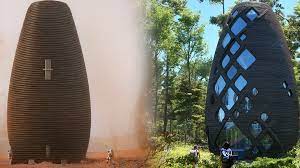
When we think of Mars, we think of the color red. When we think of people on Mars, we think of Martians. However, what if we’re living on Mars one day? What will life be like? This blog offers a possible look at how homes on Mars may look like in the future. This could be a future that is a long way off, but with the help of innovative technologies, anything is possible. People are always looking for ways to enter the future, which could make this kind of future a reality.

AI SpaceFactory is a multi-planetary architectural and technology design agency that creates amazing spaces with minimal resources. They won the first prize for NASA’s 3D Printing Habitat Challenge Competition. NASA awarded MARSHA $500,000 prize for the successful construction of their Mars habitat.

To start off, a little background on what MARSHA is. MARSHA is an acronym for Mars Space Habitat, a prototype habitat designed to be the first of its kind. In 2016, MARSHA was constructed by a team of college students from Virginia Tech and MIT.

“We were lauded for the automation of our print – completed with nearly no human assistance in 30 hours – as well as our innovative biopolymer basalt composite, a biodegradable and recyclable material derived from natural materials found on Mars. After withstanding NASA’s pressure, smoke, and impact testing, this material was found to be stronger and more durable than its concrete competitors,” said AI SpaceFactory.

The 15-foot (4,5-metre) tall prototype was 3D printed during the final phase of NASA’s #D Printed Habitat Challenge and included three robotically-placed windows

“We developed these technologies for Space, but they have the potential to transform the way we build on Earth,” said David Malott, CEO and Founder of AI SpaceFactory. “By using natural, biodegradable materials grown from crops, we could eliminate the building industry’s massive waste of unrecyclable concrete and restore our planet.”

MARSHA will have comforts and all the necessities required to remain in a healthy mindset while living in isolated conditions. MARSHA is also built to withstand the radiation in the environment of Mars.

Since the Industrial Revolution, people have been focused on expanding our natural resources. As a result, we’ve created many things that are not meant to last. Things like plastics, styrofoam, and even electronics can take years to decompose. All these materials can end up in the ocean and landfills, which is not good for the environment. What if we could change that? AI SpaceFactory. plans to recycle the materials from MARSHA and re-use them to 3D print TERA, the first-ever space-tech eco-habitat on Earth.

More than 60 teams participated throughout the competition, and NASA awarded over $2 million in prize money. The challenge structure allowed NASA to task the teams to address many facets of 3D construction, and to involve a broader range of teams with various expertise. MARSHA came out to be the winning home for a Martian stay.




